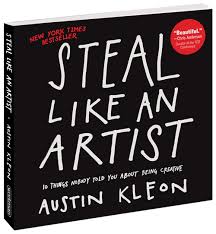 Whenever I am in Manhattan with a few extra hours, I love to visit The Strand (it’s the East Coast version of Powell’s for me). It’s one of those bookstores that seems to embody what a bookstore should be, especially in the basement: overcrowded, a touch chaotic, and full of perfectly pleasant employees who are happy to help…but you know they’d prefer that everybody left so they could get back to reading.
Whenever I am in Manhattan with a few extra hours, I love to visit The Strand (it’s the East Coast version of Powell’s for me). It’s one of those bookstores that seems to embody what a bookstore should be, especially in the basement: overcrowded, a touch chaotic, and full of perfectly pleasant employees who are happy to help…but you know they’d prefer that everybody left so they could get back to reading.
On a recent visit I picked up Austin Kleon’s Steal Like an Artist. I recognized his name from a quote that I found (see below). It’s a great example of a bathroom book: perfect for 5-minute reads or as a companion for a bathtub soak. I have a pretty good stash at home already, so I don’t go out of my way looking for new ones.
Flipping through it for a few minutes, though, I felt it was a good addition to that collection. And after devouring it on the plane ride home, there was a lot of fantastic material that I could steal to use for my own creative endeavors.
Big Thought

I’m not sure if there is one big thought here, but if there was I think it would go something like this: Creativity isn’t about generating novel flashes of genius. It’s about about soaking up what’s come before and then making something new out of it. This in itself isn’t a new idea (Scott Berkun’s The Dance of the Possible is another great look at the idea), but it’s a reminder that we consistently and regularly need.
Ideas, Implications, and Questions
Steal Like an Artist can jog you out of where you are and get you moving to where you want to go. Here are a few of my favorite sections:
- Make Things, Know Thyself – Austin points out that you shouldn’t wait until you feel confident and fully-cooked to start creating. In fact, the process of creating is how you figure out who you are. I laughed when I read this because I often tell people that you write a book to figure out what it’s really about. You don’t have to know beforehand, the writing is the journey. So it goes with our lives, too.
- “Don’t just steal the style, steal the thinking behind the style.” (36) What is the difference between the copycat artists and the ones who steal and make something better? It’s how deeply they dive in. By figuring out what your heroes were trying to do, you can insert yourself into the process more effectively. I was reminded of Mark Ronson’s TED Talk about the processes of remixing music into something new.
 Get Yourself A Calendar – Austin references the same calendar method from Jerry Seinfeld that I use. Get a calendar, put an X on every day that you produce, and start a string of days. Keep it going as long as you can. It’s how I keep myself writing. If you want to get yourself into the right creative habits, this is a great experiment to try.
Get Yourself A Calendar – Austin references the same calendar method from Jerry Seinfeld that I use. Get a calendar, put an X on every day that you produce, and start a string of days. Keep it going as long as you can. It’s how I keep myself writing. If you want to get yourself into the right creative habits, this is a great experiment to try.- “Sometimes by the time people catch on to what’s valuable about what you do, you’re either a) bored to death with it, or b) dead. (112) It reminds of my days playing in a band when there were 10 people in the audience. It was a good thing we liked playing our music. We amused ourselves just trying to crack each other up. If we were waiting for outside validation, we’d still be waiting. I also keep this in mind when I’m tired of talking about my books – I remind myself that there’s a lot of people who haven’t heard my message yet and it’s still fresh for them.
- That ties in well with Austin’s admonishment to Write the Book You Want to Read. Whenever I try to write an article or a book or a poem the way I think it should be written, it usually lands a little flat. When I write something that I like personally, it’s much more likely to spread way beyond me. Ironic, but true.
- Speaking of irony, here’s a line from the book’s Amazon page: “…The result is inspiring, hip, original, practical, and entertaining. And filled with new truths about creativity: Nothing is original…” (Austin, your publisher is either intentionally or unintentionally hilarious.)
Should you read this book? Who should read this book?
Sure thing. As I mentioned, it’s a perfect bathroom book. Which means it would also be a good addition to a pile of books on your desk or next to your bed. But I’d keep it someplace where you can pick it up when you are stuck or adrift or not quite confident in your next step. Then you can take it, flip through a few pages, and get an idea that you can act on. Steal Like an Artist is great for:
- Salespeople! I made the argument in Hyper-Connected Selling that salespeople are creatives who are tasked with making something new. I think that creativity is one of the key ingredients in future success in the sales world.
- Professional creatives: the graphic designers, blog writers, and video editors of the world. It’s easy to get caught up in the mundane nature of the craft. I think that there are good ideas here to help trigger the creative spark in work made for hire.
- Entrepreneurs and business owners are essentially artists who create products and services. The best ones definitely steal like artists. If you are starting or building an enterprise, it’s worth keeping this book around.
- High school and college students: there are a lot of wrong ideas about what creativity means and this could put them on the right path.
